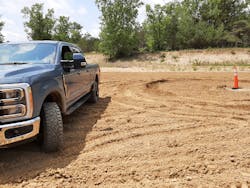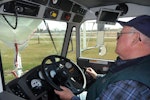Test drive of Ford 2023 Super Duties reveal power, technologies
Constant improvement and innovation seem to be the watchwords at Ford Motor Co., the leader in sales of pickup trucks for many years. It claims nearly half of all sales of construction trucks, and that and more in other segments. In mid-June, representatives showed off the builder’s latest Super Duty models, from F-250 to F-550 and -600, the latter two built as chassis-cab trucks that are outfitted with special work bodies. The event was at the company’s proving grounds near Romeo, Michigan. The “all-new” 2023 Super Duties really aren’t, as styling isn’t changed much and many pieces carry over from previous products. They include aluminum bodies and beds, and a lineup of gasoline and diesel engines.
More details on the Ford Super Duty technologies.
But Ford lists many interior improvements, including fully reclining seat backs, center console storage details, and more steps to help climbing into a bed. And technical advancements are a-plenty: Ford’s long-running Power Stroke V-8 diesel has been tweaked to produce 500 horsepower and 1,200 lb.-ft. of torque in a High Output version that can pull a trailer weighing up to 40,000 pounds. The standard rating is 475 horsepower and 1,050 lb.-ft. that will tow a 37,000-pound trailer. All that performance comes from just 406 cubic inches (advertised as 6.7 liters) armed with advanced mechanical and electronic engineering.
My first drive was with an F-450 dually pickup, powered by the HO diesel and hitched to a Towmaster three-axle gooseneck trailer stacked with boxes of pig iron. Huge lettering atop the load proclaimed the trailer’s weight, and my guide, engineer James Konstantino, said the truck weighed about 8,800 pounds with him and me aboard.
Read also: ICE dominates pickups, but electrics proliferate
An F-450 sits on a Class 3 chassis, not a Class 4 as the “450” might imply, Konstantino said. The F-450’s forte is pulling, and an F-350 is more about hauling. This was a Regular Cab truck with the base XL trim usually chosen by municipal and other cost-conscious fleet customers. He directed me around the proving grounds that include 39,000 acres and more than 100 miles of roadways. We used a few miles of that to climb and descend 7 percent grades that gave the truck a workout.
Driving this rig was very unpickup-like. There was some healthy bouncing over pavement irregularities, and a bit of backward yanking as the trailer tried to slow us. Meanwhile, the powertrain shuddered slightly when I accelerated, sending all that power and torque down the driveline and into the rear axle. It really was more like a heavy-duty experience; with a gross combination weight of almost 49,000 pounds, we actually were well into Class 8 territory, which starts at 33,001.
I began the 7-percent climb without a running start, and the powerful Ford accelerated to about 35 mph as the tachometer showed 2,500 to 3,000 rpm. The engine makes peak power at about 2,600, he said. Downgrade, an engine brake limited road speed to around 40 mph with the tach at 3,500.
Konstantino explained that the brake is in the turbocharger, whose adjustable vanes move to impede exhaust flow and introduce strong back pressure and serious retarding by the engine. The turbo’s waste gate was there to bleed off excess pressure, and probably did here.
There was a bit of moaning from under the hood as the turbo and engine worked to check our downhill speed. An indicator in the instrument screen said the 10-speed transmission stayed in 4th all the way down. The turbo brake could be turned on and off with a push-switch on the dash, but there weren’t the three steps that heavy-truck Jake Brakes have. Ford’s specs did not include HO Power Stroke’s retarding horsepower, but I will guesstimate it at about 300. It was enough that I never had to use the service brakes on the downgrade.
Meanwhile, the redesigned Super Duties have several electronic driver-assist features that can be rather useful. For example, on-board scales, now optional on 4x4s, use potentiometers at all four corners to measure weight and list it on the info screen inside. Outside, the multidiode amber turn signal lamps within the taillights illuminate from bottom to top until a limit is reached, so a driver or loader knows when to stop.
I asked, “Do guys driving this kind of truck really care about weight?” I was told that keeping loads within limits enhances safety and allows the truck to run longer without repairs–and without voiding the warranty, not so incidentally.
Among the driving stations was an off-road course that I covered in an F-350 Super Crew with fancy Platinum trim and, more importantly, a Tremor package. That included a Dana front axle with a limited-slip differential, suspension upgrades allowing extra vertical articulation, and softer-than-usual rebounding by shock absorbers. I was pleased by the truck’s smooth ride through travel ruts and over moguls along the course.
Useful here was a front-view camera, introduced several years ago, that compensated for the serious blind area caused by any truck’s long, tall hood while cresting a hill. If you’re on a maintained trail you know that you can continue to roll, but what if there’s a sharp curve there? The camera, mounted low in the grille, sent an image of what was just ahead to the in-dash color screen.
Also noteworthy is a Trail Turn Assist feature that applies the inside rear brake during sharp turns. This drags the rear end through the turn and, I reckoned, cuts a turning circle by about two-thirds. Of course, this is to be used only on dirt, in sand, or similar underfoot conditions.
Read also: Ford F-150 hybrid wows at all levels
To its previously introduced Trailer Backing Assist, Ford has added Pro Trailer Hitch Assist. This uses a rear-facing camera and computer calculations to back the truck precisely to a trailer’s tongue and place the ball exactly beneath the waiting coupler. The driver pushes and holds a circular switch on the dash while the system operates the throttle and brakes, and manipulates the wheel as though a ghost were doing the backward steering. Drivers who couple onto trailers often won’t need the feature, but occasional towers will like it.
Also new is Smart Hitch, which uses the on-board scale to measure a trailer’s tongue weight. If that’s about 10 or so percent of the trailer’s weight, safe handling is ensured. With this feature, an operator can know whether or not tongue weight is proper before he ties down a moveable load, such as a skid steer. Demonstrators pointed out that this eases work and saves time.
By the way, the Super Duty name goes back to the 1950s, when it was applied to Ford’s heavy-duty F-800s that I remember as a kid. The name was revived in 1999 for F-250-and-up models, said Tim Baughman, general manager of Ford Pro North America, the company’s marketing and customer support arm. The latest Super Duties are more powerful and feature-rich than previous versions, upholding the series’ reputation and making drivers more productive. That’s what he and other reps told us, and it all rings true.









